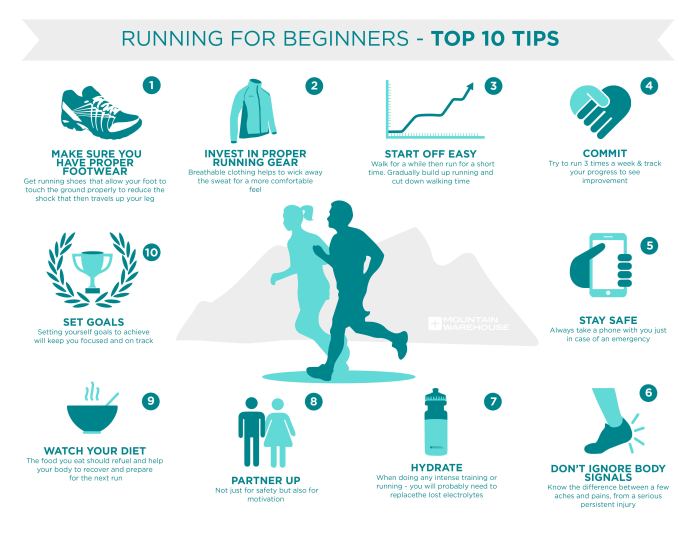
Ready to ditch the wobbly jog and embrace the graceful stride of a gazelle (or at least, a slightly less clumsy human)? This isn’t your grandma’s jogging guide – we’re diving headfirst (metaphorically, of course, unless you’re into that sort of thing) into the wild and wonderful world of running techniques and tips. Forget the boring lectures; we’re talking practical advice, hilarious anecdotes (possibly involving tripping), and enough insider knowledge to make you the envy of every park runner.
From mastering the art of breathing like a seasoned yogi to selecting shoes that won’t betray you mid-marathon, we’ll cover everything you need to know to transform your run from a painful plod to a joyous jaunt. Prepare for a journey of self-discovery, punctuated by the satisfying thud of your feet hitting the pavement (or trail, if you’re feeling adventurous).
Posture and Form
Running, at its core, is a surprisingly elegant act. Think gazelle, not giraffe. Proper posture and form aren’t just about looking good; they’re crucial for preventing injuries and maximizing efficiency. While seasoned runners might have a more nuanced style, the fundamental principles remain the same for everyone, from couch-to-5k newbies to marathon masters.
The ideal running posture, regardless of experience, involves a relaxed yet upright stance. Imagine a string gently pulling you upwards from the crown of your head. Your core should be engaged, not rigid, providing stability and preventing excessive sway. Arms should swing naturally at your sides, bent at roughly a 90-degree angle, avoiding crossing your body or clenching your fists.
Your feet should land beneath your hips, minimizing impact and maximizing propulsion. Experienced runners might exhibit a more subtle cadence and stride length adjustment based on terrain and pace, but the core principles remain consistent.
Correcting Common Running Posture Mistakes
Many common running posture problems stem from muscle imbalances, poor habits, or simply a lack of awareness. Addressing these issues can significantly improve your running experience and reduce your risk of injury.
Let’s tackle some frequent offenders and how to fix them:
| Body Part | Correct Posture | Incorrect Posture | Corrective Exercises |
|---|---|---|---|
| Head | Head held high, eyes looking forward, neck relaxed. | Head tilted down or excessively forward, straining the neck. | Neck stretches, chin tucks. |
| Shoulders | Shoulders relaxed and down, away from ears. | Shoulders hunched or raised, creating tension. | Shoulder rolls, chest stretches. |
| Back | Slight forward lean from the ankles, maintaining a straight back. | Slouching, excessive arching, or hunching. | Plank variations, back extensions. |
| Core | Engaged core muscles provide stability, preventing excessive sway. | Weak core leading to excessive torso movement. | Crunches, planks, Russian twists. |
| Hips | Neutral hip position, avoiding excessive tilting. | Hips tilting excessively forward or backward. | Hip flexor stretches, glute bridges. |
| Arms | Arms bent at 90 degrees, swinging naturally at the sides. | Arms swinging across the body, or clenched fists. | Arm circles, relaxed arm swings. |
| Feet | Foot landing beneath the hips, midfoot strike preferred. | Overstriding (landing far ahead of hips), heel striking. | Short, quick strides, focusing on midfoot landing. |
Visualizing Correct vs. Incorrect Posture:
Correct Posture: Imagine a perfectly aligned stack of blocks – head, shoulders, hips, knees, ankles – all neatly stacked vertically, maintaining a relaxed yet upright posture. The runner appears light on their feet, with a natural forward lean originating from the ankles, not the waist. Arms swing smoothly and effortlessly, mirroring each other in a rhythmic motion.
Incorrect Posture: Picture a wobbly Jenga tower – the runner’s body is misaligned, with the head jutting forward, shoulders hunched, and back slouching. The hips might be excessively tilted, and the arms might be flailing wildly or rigidly held. The feet might land heavily with an overstride, leading to a jarring impact.
Breathing Techniques
Ready to unlock your inner Olympian? Forget fancy shoes and miracle gels – the secret weapon to running like a gazelle is mastering the art of breathing. Proper breathing isn’t just about getting air in and out; it’s the key to maximizing endurance, boosting performance, and preventing those dreaded side stitches that feel like a tiny gremlin is stabbing you in the ribs.Breathing efficiently during a run ensures your muscles receive the oxygen they crave, preventing fatigue and allowing you to maintain a consistent pace.
Think of it as fueling your running engine – without enough oxygen, your engine sputters and stalls. This section will explore different breathing techniques, helping you find the perfect rhythm for your running style and intensity.
Breathing Patterns and Their Effectiveness
Different breathing patterns can significantly impact your running experience. Experimenting with various ratios of inhalation to exhalation can help you find what works best. A common technique is the 2:2 pattern, where you inhale for two steps and exhale for two steps. This is a good starting point for many runners, providing a relatively simple rhythm to follow.
The 3:3 pattern extends this, offering a slightly slower, more controlled breath. More advanced runners might explore 4:4 or even longer ratios, especially during longer, slower runs. Finding the right rhythm is crucial; it shouldn’t feel forced or restrictive, but rather a natural extension of your stride. The ideal pattern will depend on individual factors such as running pace, fitness level, and personal preference.
Nasal vs. Mouth Breathing During Runs of Varying Intensity
The age-old debate: nose or mouth? The answer, as with most things in life, is “it depends.” For low-intensity runs, nasal breathing is often preferred. It filters and warms the air, providing a more controlled and gentle intake of oxygen. However, as intensity increases, your body’s oxygen demand skyrockets. At this point, mouth breathing becomes essential to get enough air in quickly.
Many runners adopt a combined approach, using nasal breathing for easy runs and switching to mouth breathing during sprints or uphill sections. Think of it as a strategic alliance between your nose and mouth – each playing a vital role depending on the battlefield conditions.
A Breathing Exercise Routine for Runners
Improving breath control isn’t just about running; it’s about building a strong respiratory foundation. This routine can be done daily, even on rest days, to enhance lung capacity and overall breathing efficiency.
- Diaphragmatic Breathing (5 minutes): Lie on your back with knees bent. Place one hand on your chest and the other on your stomach. Inhale deeply, feeling your stomach rise while your chest remains relatively still. Exhale slowly, feeling your stomach fall. This focuses on using your diaphragm, the primary muscle for breathing.
- Controlled Breathing with Resistance (5 minutes): Inhale deeply through your nose, then exhale slowly through pursed lips, as if you’re blowing through a straw. This increases resistance and strengthens your respiratory muscles.
- Running Breathing Drills (10-15 minutes): Incorporate various breathing patterns (2:2, 3:3, etc.) into your regular runs. Start with shorter intervals and gradually increase the duration as your control improves. Pay close attention to how your body responds to each pattern.
Remember, consistency is key. Regular practice of these exercises will help you develop a more efficient and controlled breathing pattern, leading to improved endurance and performance on your runs. Think of it as training your breathing muscles just like you train your legs!
Training Plans and Progression
So, you’ve mastered the art of not face-planting while running (congratulations!). Now it’s time to talk about actually
- improving*. Think of your body as a finely tuned (okay, maybe not
- finely* tuned yet) engine – you need a proper training plan to get it running smoothly and efficiently, and to avoid blowing a gasket (metaphorically speaking, of course. We don’t want any actual gaskets blowing). This isn’t about becoming the next marathon champion overnight; it’s about building a sustainable running habit and gradually increasing your fitness.
A well-structured training plan is your roadmap to running success. It’s all about progressive overload: gradually increasing the intensity, duration, or frequency of your runs over time. This allows your body to adapt and get stronger without risking injury. We’ll cover creating a balanced plan that incorporates both high-intensity intervals (think short bursts of speed) and long, slow distance runs (LSD – think meditative jogging).
We’ll also discuss how to tailor your plan to your specific needs and goals, whether you’re aiming for a 5k or just want to be able to run to the mailbox without gasping for air.
Sample 8-Week Beginner Running Plan
This plan assumes you can currently comfortably run for 15 minutes without stopping. Remember, rest is crucial! Don’t push yourself too hard, especially in the beginning. Listen to your body, and don’t hesitate to take extra rest days if needed.
| Week | Monday | Tuesday | Wednesday | Thursday | Friday | Saturday | Sunday |
|---|---|---|---|---|---|---|---|
| 1 | Rest | 20 min run | Rest | 20 min run | Rest | 30 min run | Rest |
| 2 | Rest | 25 min run | Rest | 25 min run | Rest | 35 min run | Rest |
| 3 | Rest | 30 min run | Rest | 30 min run | Rest | 40 min run | Rest |
| 4 | Rest | 35 min run | Cross-training (30 min) | 35 min run | Rest | 45 min run | Rest |
| 5 | Rest | 40 min run | Rest | 40 min run | Rest | 50 min run | Rest |
| 6 | Rest | 45 min run | Cross-training (30 min) | 45 min run | Rest | 55 min run | Rest |
| 7 | Rest | 50 min run | Rest | 50 min run | Rest | 60 min run | Rest |
| 8 | Rest | 55 min run | Rest | Interval training (see below) | Rest | 60 min run | Rest |
High-Intensity Interval Training (HIIT) and Long, Slow Distance (LSD) Runs
A balanced running plan should include both HIIT and LSD runs. HIIT improves speed and cardiovascular fitness, while LSD builds endurance. This sample interval workout can be incorporated into week 8 of the beginner plan (or later, once you have a solid base):Warm-up: 10 minutes easy jogging.Intervals: 8 x 400 meters at your 5k race pace with 400 meters recovery jog between each interval.Cool-down: 10 minutes easy jogging.LSD runs, on the other hand, are all about maintaining a comfortable pace for an extended period.
Think of it as a moving meditation – a chance to clear your head and enjoy the scenery (provided the scenery isn’t a particularly unpleasant landfill).
Adapting Training Plans to Individual Fitness Levels and Goals
“There’s no one-size-fits-all approach to running. Listen to your body and adjust accordingly.”
This is crucial. If you’re a complete beginner, start slowly and gradually increase your mileage and intensity. If you’re more experienced, you can adjust the plan to include more challenging workouts and longer runs. Your goals also matter. Are you training for a specific race?
Do you just want to improve your overall fitness? Your training plan should reflect your ambitions. For example, a runner training for a marathon will need to incorporate longer runs and more endurance-focused workouts than someone who is simply aiming to maintain a healthy weight.
Running Gear and Equipment
Let’s face it, running isn’t just about the sweat and the glorious feeling of accomplishment; it’s also about the gear. Choosing the right equipment can be the difference between a PR and a pulled hamstring, a blissful run and a blister-induced meltdown. So, ditch the mismatched socks and ill-fitting shoes – let’s get you properly equipped for running victory!Proper running shoes are the unsung heroes of your running journey.
They’re the foundation upon which your entire run is built, literally. A poorly fitting or inappropriate shoe can lead to a cascade of injuries, from plantar fasciitis to runner’s knee, turning your happy jog into a painful ordeal. Think of them as your personal, cushioned shock absorbers, protecting your joints from the constant pounding of the pavement (or trail!).
Running Shoe Selection
Selecting the right running shoe is a crucial step. Consider factors such as foot type (high arch, neutral, flat), running style (overpronation, supination, neutral), and the terrain you’ll be running on. Visiting a specialty running store for a gait analysis is highly recommended. This professional assessment will help determine the type of support and cushioning your feet need.
Don’t be afraid to try on multiple pairs and walk around the store in them – you want to feel comfortable and supported. Remember, a good running shoe is an investment in your long-term running health.
Running Apparel for Various Weather Conditions
Choosing the right clothing is as important as choosing the right shoes. Think of it as a second skin, designed to regulate your body temperature and wick away sweat. For hot weather, lightweight, breathable fabrics like moisture-wicking polyester or nylon are your best bet. Avoid cotton, as it retains moisture and can chafe. In colder weather, layering is key.
Start with a base layer of thermal material to wick away sweat, followed by an insulating mid-layer (fleece or lightweight down), and a windproof and water-resistant outer layer. Don’t forget hats, gloves, and warm socks to keep your extremities warm.
Running Accessories: Benefits and Drawbacks
Running accessories can enhance your running experience, but they’re not always necessary. GPS watches provide accurate tracking of distance, pace, and heart rate, which can be motivating and helpful for training. However, they can be expensive and add an extra layer of technology to your run. Heart rate monitors offer real-time feedback on your exertion levels, helping you stay within your target heart rate zones.
However, they can be uncomfortable for some runners. Other accessories, such as running belts or armbands for phones, can be useful for carrying essentials, but make sure they’re comfortable and secure.
Essential Running Gear
Choosing the right gear can significantly impact your comfort, performance, and safety.
- Running Shoes: Look for shoes that provide adequate cushioning, support, and stability based on your foot type and running style. Consider the terrain you will be running on.
- Moisture-Wicking Socks: These help prevent blisters and keep your feet dry and comfortable. Look for materials like merino wool or synthetic blends.
- Running Apparel: Choose breathable, moisture-wicking fabrics that are appropriate for the weather conditions. Layering is recommended for colder weather.
- Hydration Pack or Water Bottle: Staying hydrated is crucial, especially during longer runs. Choose a hydration system that’s comfortable and convenient.
- Sunscreen and Sunglasses: Protect your skin and eyes from the sun’s harmful rays, especially during outdoor runs.
Injury Prevention and Recovery
So, you’ve conquered the art of running – the perfect stride, the rhythmic breathing, the endorphin rush. But even the most seasoned marathoners can fall victim to the dreaded running injury. Let’s delve into the world of preventing those pesky pains and getting back on your feet (literally!) when they strike. Think of this as your injury prevention and recovery survival guide – because let’s face it, nobody wants to spend their hard-earned free time icing a knee instead of exploring new trails.Common Running Injuries and Their CausesRunning, while a fantastic activity, can put a lot of stress on your body.
Ignoring your body’s signals often leads to problems. Let’s examine some common culprits. Runner’s knee, for example, often stems from overuse, muscle imbalances (like weak quads or tight hamstrings), or poor running form. Imagine your knee as a finely tuned machine – if one part isn’t working correctly, the whole thing can seize up. Shin splints, that nagging pain along your shinbone, are usually caused by overuse, improper footwear, or flat feet, placing excessive stress on the muscles and bones of your lower leg.
Think of it like constantly hitting the same drum – eventually, something’s going to break!
Preventing Common Running Injuries
A proper warm-up is crucial before each run. This prepares your muscles for the exertion ahead, reducing the risk of injury. A dynamic warm-up, involving movements like leg swings, arm circles, and high knees, is far more effective than just static stretching. Think of it like gently waking up your muscles before sending them into a full-on sprint.
Similarly, a cool-down helps your body gradually return to its resting state, preventing stiffness and soreness. Gentle jogging followed by static stretches, holding each for 20-30 seconds, is ideal. Regular stretching, focusing on major muscle groups like hamstrings, quads, and calves, is also vital. Think of stretching as giving your muscles a luxurious massage, keeping them supple and injury-free.
Recovering from Running Injuries
The RICE protocol – Rest, Ice, Compression, and Elevation – is your go-to strategy for minor injuries. Rest allows your body to heal, ice reduces inflammation, compression minimizes swelling, and elevation keeps fluid from pooling. For more serious injuries, physical therapy is often necessary. A physical therapist can help identify the root cause of the injury, develop a personalized rehabilitation plan, and guide you back to running safely.
Think of a physical therapist as your personal running mechanic, meticulously tuning your body back to peak performance.
Listening to Your Body and Avoiding Overtraining
This is perhaps the most important aspect of injury prevention. Pain is your body’s way of screaming “STOP!” Ignoring this signal often leads to more serious problems. Rest days are essential – allow your body time to recover and rebuild. Gradually increase your mileage and intensity to avoid overtraining. Don’t try to become a marathon runner overnight! Pay attention to your body’s cues – fatigue, persistent pain, or decreased performance are all warning signs.
Remember, consistency is key, but so is listening to your body’s wisdom. It’s a marathon, not a sprint, after all.
Nutrition and Hydration for Runners
Fueling your body correctly is as crucial to running success as lacing up your shoes. Think of your body as a high-performance engine – you wouldn’t put regular unleaded in a Ferrari, would you? Proper nutrition and hydration are the premium fuel that will keep you running strong, prevent injury, and help you achieve your running goals. Ignoring this aspect is like trying to win a marathon on a rusty bicycle.Proper nutrition plays a vital role in fueling runs and aiding recovery.
It provides the energy your muscles need to perform and the building blocks for repair after a tough workout. Hydration is equally important, as even mild dehydration can significantly impact performance and increase the risk of injury. We’ll explore the specifics of what, when, and how much to eat and drink to optimize your running experience.
Pre-Run Nutrition
A well-timed pre-run meal or snack provides sustained energy without causing digestive distress. Ideally, this should be easily digestible and relatively low in fiber to prevent stomach cramps. A light breakfast or snack 1-3 hours before your run, depending on the intensity and duration, is recommended. Examples include a banana with peanut butter, oatmeal with berries, or a small whole-wheat toast with avocado.
Avoid high-fat foods as they take longer to digest.
During-Run Nutrition
For runs lasting longer than an hour, refueling becomes necessary. This is particularly crucial for longer distances or high-intensity efforts. Simple carbohydrates, like gels, chews, or sports drinks, provide readily available energy. Water is, of course, essential for hydration. The specific needs will vary depending on the duration and intensity of the run; experimenting to find what works best for your body is key.
For example, a marathon runner might consume gels every 45 minutes, while a shorter run might not require any supplemental nutrition.
Post-Run Nutrition
Post-run nutrition focuses on replenishing glycogen stores and repairing muscle tissue. This is your body’s opportunity to recover and prepare for the next run. Consuming a mix of carbohydrates and protein within 30-60 minutes of finishing is ideal. A good example would be a protein shake with fruit or a Greek yogurt with granola. This combination helps replenish energy levels and promotes muscle recovery.
Nutritional Value of Foods for Runners
The following table compares the nutritional value of several foods commonly consumed by runners. Remember, individual needs vary, so it’s essential to tailor your diet to your own training and body type.
| Food | Calories (approx.) | Carbohydrates (g) | Protein (g) | Fat (g) |
|---|---|---|---|---|
| Banana | 105 | 27 | 1 | 0 |
| Oatmeal (1/2 cup cooked) | 150 | 27 | 5 | 2 |
| Whole Wheat Toast (1 slice) | 70 | 13 | 3 | 1 |
| Peanut Butter (2 tbsp) | 190 | 7 | 7 | 16 |
| Greek Yogurt (1 cup) | 150 | 10 | 20 | 2 |
Hydration Strategies
Hydration is not just about drinking water when you’re thirsty; it’s about proactively maintaining optimal hydration levels throughout the day, especially before, during, and after runs. Begin hydrating well before your run, even the day before for longer distances. During your run, sip water regularly, especially in hot and humid conditions. Electrolyte drinks can be beneficial for longer runs to replace lost salts.
After your run, replenish fluids lost through sweat by drinking plenty of water or electrolyte beverages. Pay attention to your body’s signals – thirst is a late indicator of dehydration. Regularly monitor your urine color; a pale yellow color indicates good hydration.
Mental Aspects of Running

Conquering a marathon isn’t just about physical endurance; it’s a mental battleground where willpower and strategy clash with exhaustion and doubt. This section delves into the psychological strategies that can transform you from a hesitant runner into a mental powerhouse, ready to tackle any distance. We’ll explore techniques to bolster motivation, manage stress, and cultivate a mindset that fuels your running journey.
Running, like life, throws curveballs. Injuries, setbacks, and the sheer monotony of training can test even the most dedicated runner’s resolve. But by understanding and employing the right mental strategies, you can not only overcome these challenges but use them as stepping stones to greater strength and resilience.
Setting Realistic Goals and Tracking Progress
Setting realistic goals is crucial for maintaining motivation. Instead of aiming for a drastic improvement overnight, focus on incremental progress. For instance, if your current 5k time is 30 minutes, don’t aim for a 20-minute 5k next week. Instead, aim for a 28-minute 5k, then 26 minutes the following week, and so on. Tracking progress, whether through a running app or a simple notebook, provides tangible evidence of your achievements, fueling your motivation and demonstrating the effectiveness of your training.
Visualizing your progress, perhaps with a chart illustrating your improvement over time, can be particularly motivating. This provides a powerful sense of accomplishment and reinforces the positive feedback loop of consistent effort and improvement.
The Role of Mindfulness and Meditation in Enhancing Running Performance
Mindfulness and meditation techniques can significantly enhance running performance by improving focus, reducing stress, and increasing body awareness. Mindfulness involves paying attention to the present moment without judgment. During a run, this could mean focusing on the rhythm of your breath, the feeling of your feet hitting the ground, or the scenery around you. Meditation, a more formal practice, cultivates a calm and centered state of mind, which can be incredibly beneficial before, during, or after a run.
Regular meditation can reduce anxiety and improve sleep quality, both crucial for optimal performance. Imagine the feeling of centered calm before a race, reducing pre-race jitters and allowing you to focus on your performance.
Managing Stress and Anxiety Related to Running
Running itself can be a fantastic stress reliever, but the pressure to perform, fear of injury, or even the sheer commitment required can generate significant stress and anxiety. Developing effective coping mechanisms is vital. Techniques like deep breathing exercises, progressive muscle relaxation, and visualization can help manage these feelings. Deep breathing, for example, can calm your nervous system in stressful situations, such as before a race.
Progressive muscle relaxation involves systematically tensing and releasing different muscle groups, releasing physical tension that often accompanies mental stress. Visualization involves mentally rehearsing a successful run, building confidence and reducing anxiety. Remembering that running is supposed to be enjoyable, and focusing on the positive aspects, can also significantly improve your mental wellbeing and performance.
Health Fitness Considerations
Running isn’t just about pounding the pavement; it’s a holistic health booster, a fantastic way to improve your overall well-being and fitness level. Think of it as a multifaceted weapon in your fight against a sedentary lifestyle and its associated woes. It’s not just about shedding pounds (though that’s a nice side effect!), but about strengthening your heart, sharpening your mind, and generally feeling more alive.Running’s impact on your health is significant and far-reaching, affecting multiple systems in your body in positive ways.
Let’s dive into the specifics of how this simple act of putting one foot in front of the other can dramatically improve your life.
Cardiovascular Benefits of Running
Regular running strengthens your heart muscle, making it more efficient at pumping blood. This leads to lower resting heart rate and blood pressure, reducing your risk of heart disease, stroke, and other cardiovascular ailments. Imagine your heart as a finely tuned engine; running helps it operate smoothly and powerfully, reducing wear and tear over time. Studies have consistently shown a strong correlation between regular running and improved cardiovascular health, with runners often exhibiting significantly lower risks of heart-related issues compared to sedentary individuals.
For example, a meta-analysis of numerous studies published in the “Journal of the American Medical Association” demonstrated a considerable reduction in cardiovascular mortality among individuals who engaged in regular running.
Running and Weight Management
Running burns calories, plain and simple. The number of calories burned depends on factors like your weight, intensity, and duration of your run, but even a moderate jog can significantly contribute to a calorie deficit, crucial for weight loss or maintenance. Furthermore, running helps build lean muscle mass, which boosts your metabolism, meaning you burn more calories even at rest.
This isn’t just about dropping pounds on the scale; it’s about improving your body composition, reducing body fat percentage, and increasing muscle mass – leading to a healthier, more toned physique. Consider a person who incorporates 30 minutes of running three times a week into their routine alongside a balanced diet. They are likely to see a noticeable reduction in body fat and an increase in muscle tone over time.
Potential Risks of Running and Mitigation Strategies
While running offers numerous benefits, it’s crucial to acknowledge potential risks. Overuse injuries, such as runner’s knee or shin splints, are common, particularly among those who increase their mileage too quickly or have improper form. Other risks include stress fractures and ankle sprains. However, these risks can be significantly mitigated. Proper training plans with gradual increases in mileage, appropriate footwear, stretching and strengthening exercises, and listening to your body are essential.
A gradual increase in running distance, coupled with regular rest days and cross-training activities, can significantly reduce the risk of overuse injuries. Similarly, wearing properly fitted running shoes and incorporating strength training exercises can help prevent injuries by improving muscle strength and balance. Paying attention to your body’s signals, such as pain or fatigue, and taking rest days when needed, is crucial for injury prevention.
Final Summary

So, there you have it: a whirlwind tour of running techniques and tips to help you conquer the pavement (or trail!) and become the running superhero you were always meant to be. Remember, consistency is key – even superheroes need their rest days. And maybe a slightly less superhero-like recovery snack. Now go forth, and run like the wind (or at least, a slightly less windy breeze)! Don’t forget to share your triumphant (or hilariously disastrous) running stories with us – we’re always looking for a good laugh (and a bit of inspiration).
FAQ Overview
What’s the best time of day to run?
Whenever your body feels best! Listen to your internal clock; some thrive in the morning, others prefer the evening coolness.
How often should I run?
Start slowly, building up gradually. Aim for consistency rather than intensity, especially as a beginner. Three runs a week is a great starting point.
How do I avoid runner’s knee?
Proper form, gradual training increases, and strengthening exercises for your quads and hamstrings are crucial. Listen to your body!
What should I eat before a run?
Light carbs are your friend! Avoid anything too heavy or greasy. A banana or a small energy bar can be ideal.
Should I run through pain?
Absolutely not! Pain is your body’s way of saying “STOP!” Rest, ice, and seek professional advice if needed.





